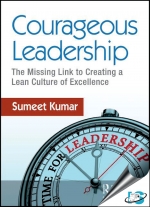Tab Article
Courageous Leadership: The Missing Link to Creating a Lean Culture of Excellence is one of the firsts of its kind to wade through the confusion among leaders on selecting the type of change approach that will get the best results in their organization. It educates the senior executive leaders and organizational excellence practitioners on the different characteristics of change and answers why the approach to incremental and transitional change cannot deliver the results expected from a transformational change. The author shares his experiences from leading several small and large scale organization transformations in multiple industries across different countries on how to establish a robust foundation for an excellence journey and integrate strategy into daily operations. This book elaborates on the types of courage and what it means to be a courageous leader while leading change in difficult situations, and what leaders do differently for putting the organization on a path to excellence and culture transformation.
This book shares an innovative design, a methodology and an approach that combines best practices and principles from Malcolm Baldrige, Shingo, Lean, Six Sigma, Balanced Scorecard, accreditation, change management, patient and family-centered care, the Competing Values Framework, the LEADS framework, and the project management body of knowledge. The implementation of this model at a hospital in Canada propelled the organization further ahead on their transformational journey compared to other organizations that started much earlier. Sensei in Japanese means Teacher and Gyaan in Sanskrit means Knowledge. Brief sections on ‘Sensei Gyaan’ have been interspersed throughout the book to provide valuable tips to the readers based on author’s experiential learnings over the past two decades.
This book serves as a practical guide for senior executive leaders and organizational excellence practitioners, who wish to embark or are in various stages of their organizational excellence and culture transformation journey. Readers will be guided through 26 elements necessary for establishing a robust foundation and an additional set of 22 Management System elements required to create and sustain a culture of quality across the organization. For leaders in healthcare, the book provides a framework, guiding principles, and associated practices that support the implementation of the 4 core concepts of patient and family centered care namely, dignity and respect, information sharing, participation and collaboration. Included in the book are several examples with creative visuals, ready-to-use templates and standard works, models, guiding principles, and strategies based on best practices to assist leaders in their organization excellence journey.


